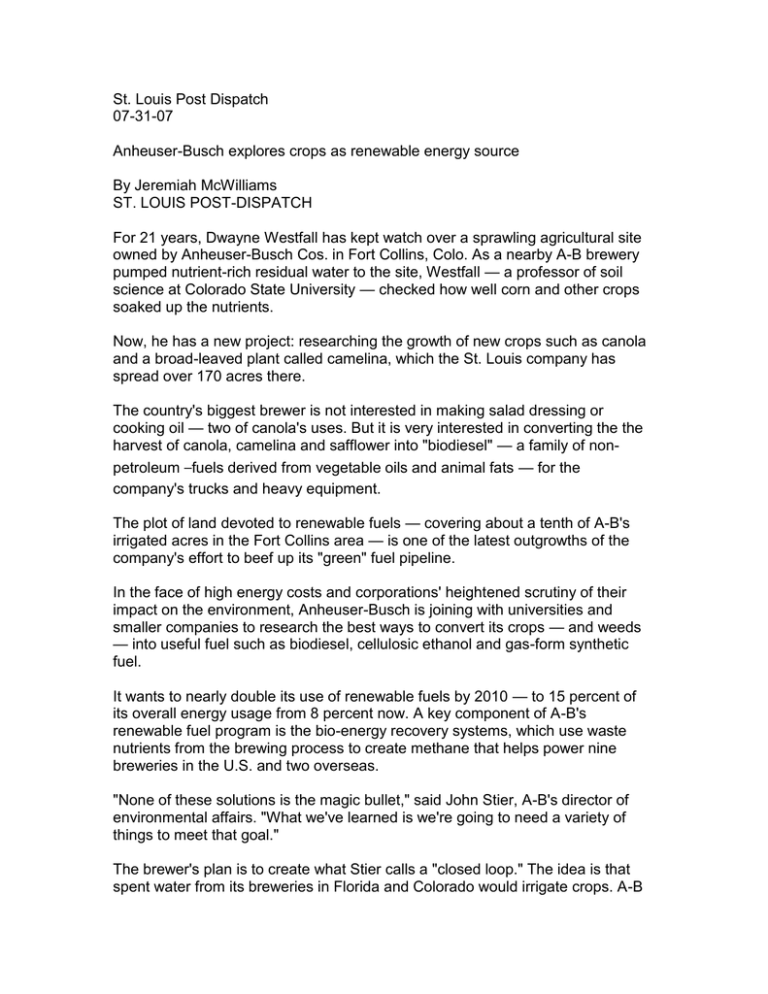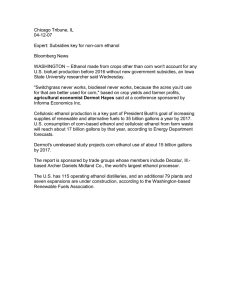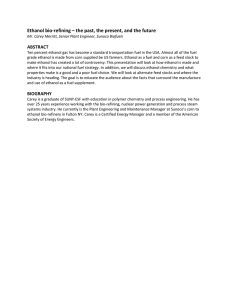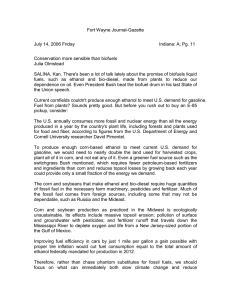St. Louis Post Dispatch 07-31-07 Anheuser-Busch explores crops as renewable energy source
advertisement

St. Louis Post Dispatch 07-31-07 Anheuser-Busch explores crops as renewable energy source By Jeremiah McWilliams ST. LOUIS POST-DISPATCH For 21 years, Dwayne Westfall has kept watch over a sprawling agricultural site owned by Anheuser-Busch Cos. in Fort Collins, Colo. As a nearby A-B brewery pumped nutrient-rich residual water to the site, Westfall — a professor of soil science at Colorado State University — checked how well corn and other crops soaked up the nutrients. Now, he has a new project: researching the growth of new crops such as canola and a broad-leaved plant called camelina, which the St. Louis company has spread over 170 acres there. The country's biggest brewer is not interested in making salad dressing or cooking oil — two of canola's uses. But it is very interested in converting the the harvest of canola, camelina and safflower into "biodiesel" — a family of nonpetroleum –fuels derived from vegetable oils and animal fats — for the company's trucks and heavy equipment. The plot of land devoted to renewable fuels — covering about a tenth of A-B's irrigated acres in the Fort Collins area — is one of the latest outgrowths of the company's effort to beef up its "green" fuel pipeline. In the face of high energy costs and corporations' heightened scrutiny of their impact on the environment, Anheuser-Busch is joining with universities and smaller companies to research the best ways to convert its crops — and weeds — into useful fuel such as biodiesel, cellulosic ethanol and gas-form synthetic fuel. It wants to nearly double its use of renewable fuels by 2010 — to 15 percent of its overall energy usage from 8 percent now. A key component of A-B's renewable fuel program is the bio-energy recovery systems, which use waste nutrients from the brewing process to create methane that helps power nine breweries in the U.S. and two overseas. "None of these solutions is the magic bullet," said John Stier, A-B's director of environmental affairs. "What we've learned is we're going to need a variety of things to meet that goal." The brewer's plan is to create what Stier calls a "closed loop." The idea is that spent water from its breweries in Florida and Colorado would irrigate crops. A-B then would harvest and send the crops to a renewable fuel company, which would convert the material into fuel sources to power the brewer's trucks, heavy equipment and possibly breweries in Florida and Colorado. Some of the experiments have humble beginnings. The company has planted switchgrass on two acres in Jacksonville, Fla., so University of Florida researchers can determine which native grasses yield the most "cellulosic ethanol," alcohol derived carbohydrates in cell walls of wood chips or grasses. Alternatively, a mulching process could convert the plants to gases to fire the boilers in the company's Jacksonville brewery, Stier said. Hundreds of millions of dollars have been pumped into building plants to process corn into ethanol. But cellulosic ethanol is years away from being commercially viable, industry watchers say. "It's technically feasible to make ethanol out of a lot of things. It's just not costeffective," said Chad Hart, a scientist at Iowa State University's Center for Agricultural and Rural Development. A-B will be "in on the ground floor if they can get this thing up." For ethanol to be produced from plant stalks, complex cellulose molecules must be broken down into simple sugars, said Timothy Donohue, a professor at the University of Wisconsin-Madison who works as scientific director for the Great Lakes Bioenergy Research Center. The technology doesn't yet exist to do that. "This is not your favorite TV show where you give me a sample, and I tell you who the murderer is," said Donohue. "This is going to take some time." Still, cellulosic ethanol might someday help A-B solve a puzzle: how to hop on ethanol without driving up corn prices. The recent surge in ethanol demand has sent corn prices spiraling higher. That's a serious issue for A-B, which uses corn as an ingredient in some of its beer. The brewer already is facing higher commodity costs next year as ethanol demand helps drive up corn prices. Anheuser-Busch executives stress that the company is making progress on the "green" fronts — both burnishing its environmentalism and saving cash. "The key here is this is just one piece of an overall plan" to lower greenhouse gas emissions and squeeze out renewable sources of fuel, Stier said. Anheuser-Busch is not alone. Rivals also are focusing on renewable energy use. At London-based SABMiller — the parent company of Milwaukee's Miller Brewing Co. — some of its operations in India use energy from the combustion of coconut and rice husks. In Honduras, its sugar mill uses sugar cane scraps as a fuel source. Coors Brewing Co. has an ethanol plant at its flagship brewery in Golden, Colo. The plant can convert brewing wastes into 3 million gallons of ethanol a year. The ethanol is mixed into gasoline sold at Valero Energy Corp.'s Diamond Shamrock gas stations in Colorado, providing a nifty sideline for the country's third-largest brewer. "A lot of cars in Colorado drive around on Coors beer," said Bob Merchant, vice president of product supply and manufacturing at Coors Brewing. jmcwilliams@post-dispatch.com | 314-340-8372





